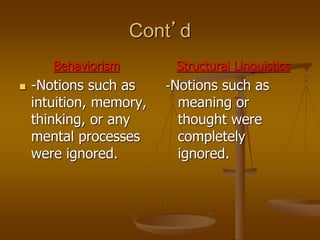1-Schools of Thought in Second Language Learning.ppt
- 1. Schools of Thought in Second Language Learning (1940’s - 2000’s) Source: Brown, D. Principles of Language Learning and Teaching. (p.p.9-15)
- 2. Trends in Linguistics and Psychology Psychology 1940’s-1950’s: Behaviorism/ Neobehaviorism -1960’s: Cognitive Psychology Linguistics 1940’s-1950’s: Structural Linguistics -1960’s: Transformational- Generative School
- 3. 1940’s-1950’s Behaviorism -It focused only on publicly observable behaviors Structural Linguistics -Only observable linguistic behaviors can be studied. Language could be dismantled into small pieces or units, described scientifically, contrasted, then added up again to form the whole.
- 4. Cont’d Behaviorism -Notions such as intuition, memory, thinking, or any mental processes were ignored. Structural Linguistics -Notions such as meaning or thought were completely ignored.
- 5. Cont’d Behaviorism -Learning a behavior: through conditioning ‘organisms’ to respond in desired ways to stimuli --} Practice/ drilling is important. Structural Ling. -Learning language: conditioning learners to make the right connection between stimuli and the desired responses --} Drilling in the language classroom was a dominant method.
- 6. Cont’d Behaviorism -Reinforcement (Positive or negative) plays an important role in learning. Structural Ling. -Positive/ negative reinforcement play a significant role in language learning.
- 7. The 1960’s - 1980’s Cognitive Psychology -Meaning, understanding, and knowing are important psychological data. Transformational- Generative Linguistics -They broke away from the structuralists’ insistence on only studying observable language (performance)
- 8. Cont’d Cognitive Psychology -Cognitivists sought to discover underlying motivation and deeper structures of human behavior. Transformational- Generative Linguistics -Linguistics goes beyond mere description of the surface structure of language.
- 9. Cont’d Cog. Psych. -Instead of focusing on the mechanical stimulus-response connections, cognitivists tried to focus on psychological principles of organization and functioning. T-G Linguistics -Studying competence reveals the hidden level of meaning and thought (deep structure) that generates the observable performance. -learning language: language is species- specific; it is innate: human beings are born with the ability to learn language.
- 10. The 1980’s – 2000’s Constructivism It involves the integration of linguistic, psychological, and sociological paradigms. The active role of the learner is emphasized. A. Cognitive constructivism: emphasizes the role of the learner in constructing his/her own representation of reality:
- 11. Constructivism -Learners must transform complex information to make it their own. A more active role for students in their learning. Piaget argues that, “learning is a developmental process that involves change, self-generation, and construction, each building on prior experiences.” (in Kaufman, 2004).
- 12. Constructivism B. Social Constructivism: emphasizes the importance of social interaction and cooperative learning in constructing cognitive and emotional images of reality. Language learning is a result of thinking and meaning-making that is “socially constructed and emerges out of [learners’] social interactions with the environment.” (Brown, p. 13)
- 13. What is the Best Theory? No single theory is right or wrong all the way! “Some truth can be found in every critical approach to the study of reality.” (Brown, p. 14)











![Constructivism
B. Social Constructivism: emphasizes the
importance of social interaction and
cooperative learning in constructing
cognitive and emotional images of reality.
Language learning is a result of thinking
and meaning-making that is “socially
constructed and emerges out of
[learners’] social interactions with the
environment.” (Brown, p. 13)](https://image.slidesharecdn.com/1-schoolsofthoughtinsecondlanguagelearning-240706010058-d677c665/85/1-Schools-of-Thought-in-Second-Language-Learning-ppt-12-320.jpg)
